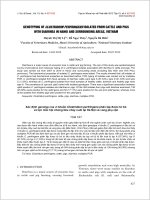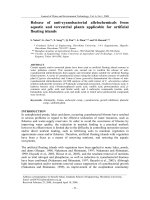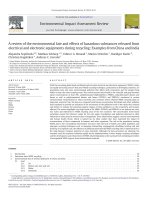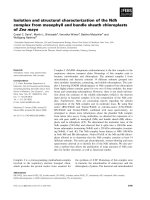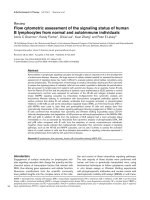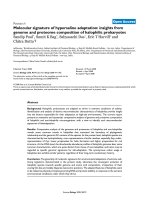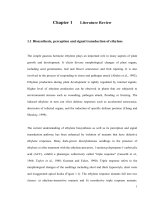Nutritional composition of functional extrudates developed from wheat and black gram
Bạn đang xem bản rút gọn của tài liệu. Xem và tải ngay bản đầy đủ của tài liệu tại đây (270.48 KB, 7 trang )
Int.J.Curr.Microbiol.App.Sci (2018) 7(8): 375-381
International Journal of Current Microbiology and Applied Sciences
ISSN: 2319-7706 Volume 7 Number 08 (2018)
Journal homepage:
Original Research Article
/>
Nutritional Composition of Functional Extrudates Developed
from Wheat and Black Gram
Anjali and Varsha Rani*
Department of Foods and Nutrition, COHS, CCS Haryana Agricultural University, Hisar,
Haryana, India
*Corresponding author
ABSTRACT
Keywords
Macaroni, Noodles,
Protein, Minerals,
Sugars, Fiber,
Digestibility
Article Info
Accepted:
04 July 2018
Available Online:
10 August 2018
In current scenario where the burden of nutritional deficiencies, allergic conditions, and
progression of degenerative diseases is so increasing due to highly polluted food
ingredients, the consumers have become more conscious about healthy eating based on the
consumption of functional foods. Black gram is perfect combination of all nutrients, which
includes proteins, carbohydrates, fat, ash, zinc, iron and calcium. It stands next to soybean
in its dietary protein content. This study was conducted to develop the macaroni and
noodles using composite flour of wheat and black gram (85:15). The proximate, sugars,
anti-nutrients, total and available minerals and in vitro digestibility of starch and protein of
macaroni and noodles were analyzed using standard methods. To compare the means and
standard deviations of various parameters between control and supplemented macaroni
independent t-test was applied on data. The crude protein, fat, ash and crude fiber contents
in macaroni and noodles supplemented with 15 per cent black gram flour ranged from
11.21 to11.63, 13.37 to 13.83, 3.52 to 3.86 and 2.98 to 3.10 per cent, respectively. Results
showed that black gram supplemented noodles and macaroni had significantly (P≤0.05)
higher contents of crude protein, crude fat, crude fiber, ash, calcium, iron, zinc, available
calcium and available iron than that of control products using whole wheat flour. Black
gram up to 15 per can be successfully incorporated cent in the development of macaroni
and noodles to enhance the nutritive value without affecting their sensory attributes.
Introduction
Noodles and macaroni are very popular pasta
products in India and the most preferred food
among children and adolescents (Sanghvi,
2008). The increasing production and
popularity of pasta products in India could be
attributed to its, low cost, ease of preparation,
sensory quality and good storage stability
(Sowbhagya and Ali, 2001). A variety of
snack foods and breakfast cereals can be
produced using extrusion. Extrusion could be
used to produce innovative products such as
cereal-based snacks, precooked breakfast
cereals, etc. Extrusion technique is one of the
most common and popular processing
techniques among the manufacturers due to its
convenience and affordability. Extrusion
cooking has been investigated as a means of
producing snacks that can be tailored to meet
the dietary requirements of particular groups
of the population. The development of
375
Int.J.Curr.Microbiol.App.Sci (2018) 7(8): 375-381
composite extrudates with the mixture of
starchy raw materials with other high quality
raw material has been an alternative for
obtaining extruded snacks with better sensory,
physic-chemical and nutritional characteristics
(Guy, 2001). The use of high quality protein
yielded from inexpensive resources like
cereal-pulse based composite flour might be
the judicious solution in eradicating protein
energy malnutrition which is highly prevalent
among children.
Development of baked and extruded products
prepared with cereal-pulse composite flour
can dramatically improve the protein quality
of final product as the composition of amino
acids in their proteins is complement to each
other. The cereals have been found to be
deficient in one or more essential amino acids
like lysine and threonine another side there is
a lack of methionine in pulse protein. There
are enough scientific evidences which confirm
the product quality enhancement (Zhao et al.,
2005; Herken et al., 2006; Shogren et al.,
2006; Wood, 2009) both in terms of sensory
and nutritionally. As the cereals are starchy
staple and contain optimum amount of protein
which is again incomplete in terms of essential
amino acids, the pulses- cereals based
composite flour become the judicious
alternate.
Black gram is perfect combination of all
nutrients, which includes proteins (23%),
carbohydrates (51%), fat (1.7%), ash (3.17%),
zinc (3.00mg), iron (5.97mg) and calcium
(55.64mg). It stands next to soybean in its
dietary protein content. Keeping in view the
consumer demand of value added extruded
products from whole wheat grain flour
supplemented with pulses flour and
unavailability of these products in current
market, the present study was designed to
develop black gram supplemented macaroni
and noodles and to analyze nutritional
composition of the same.
Materials and Methods
The bulk samples of black gram variety (UH01) and wheat variety (WH-711) were
procured from the Pulses section and Wheat
and Barley section of Department of Genetics
and Plant Breeding, CCSHAU, Hisar,
respectively. Other ingredients used in the
preparation of different baked and extruded
products were procured from the local market
in a single lot. The wheat and black gram
grains were cleaned of dust and other foreign
material. Macaroni and noodles were prepared
by incorporating 15 per cent black gram flour
along with wheat flour in extrusion machine.
Protein, fat, crude fibre, ash were determined
by the standard method of AOAC (2010). A
factor of 6.25was applied to convert the
amount of nitrogen to crude protein. Total
soluble sugars were extracted by refluxing in
80 per cent ethanol by the method of Cerning
and Guilhot (1973). Starch from sugar free
pellet was extracted in 52 per cent perchloric
acid at room temperature by employing the
method of Clegg (1956). Quantitative
determination of total soluble sugars and
starch was carried out by Colorimetric
method. Reducing sugars were estimated by
Somogy’s modified method (1945). Non
reducing sugars were determined by
calculating the difference between total
soluble sugars and reducing sugars. Phytic
acid was determined colorimetrically using a
spectrophotometer at 465 nm (Davies and
Reid, 1979). The amount of phenolic
compounds was estimated as tannic acid
equivalent according to Folin-denis reagent
(Swain and Hills, 1956).
Starch digestibility (in vitro) was assessed by
employing pancreatic amylase and incubating
at 370C for two hours. Liberated maltose was
measured
colorimetrically
by
using
dinitrosalicylic acid reagent at 550 nm (Singh
et al., 1982). Protein digestibility (in vitro)
376
Int.J.Curr.Microbiol.App.Sci (2018) 7(8): 375-381
was carried out by the modified method of
Mertz et al., (1983). The nitrogen contents of
the sample and the undigested residue were
determined by the micro-kjeldhal method of
AOAC (2010). The digested protein of the
sample was calculated by subtracting residual
protein from total protein of the sample and
per cent protein digested was calculated. For
the determination of minerals, samples were
digested in di-acid mixture. Calcium, iron and
zinc were determined by atomic absorption
spectrophotometer according to the method of
Lindsey and Norwell (1969), whereas
phosphorus was determined colorimetrically
by the method of Chen et al., 1956. Available
calcium in the samples of black gram and
wheat were extracted by method of Kim and
Zemel (1986). Ionizable iron in the samples
was extracted according to the procedure of
Rao and Prabhavati (1978).
Statistical analysis
Statistically data were analyzed using SPSS
statistical package (version 11.0) for windows
(SPSS Inc., Chicago IL, USA). To compare
the means and standard deviations of various
parameters between control and supplemented
macaroni independent t-test was applied on
data.
Results and Discussion
The moisture content of developed macaroni
ranged between 61.46 to 63.60 per cent.
However, it did not differ significantly
between the macaroni developed using 15 per
cent level of black gram flour and control
(wheat flour). The contents of crude protein,
fat, ash and crude fiber of 15 per cent black
gram
supplemented
macaroni
were
significantly (P≤0.05) higher than that of
control macaroni. The moisture content of
developed noodles ranged between 58.0260.60 per cent. However, it did not differ
significantly between the macaroni developed
using 15 per cent level of black gram flour and
control. The contents of crude protein, fat, ash
and crude fiber of 15 per cent black gram
supplemented noodle were also significantly
(P≤0.05) higher than that of control noodles.
The results of present are corroborated with
those of Reddy et al., (2014) who explored
that the fiber content of the RTE extruded
snack developed using corn, black gram and
roots and tubers was increased two-fold on
addition of roots and tuber flours along with
corn and black gram than RTE developed
from refined flour. The protein content of the
control and the experimental samples were in
the range 10.46 to 11.91g. The highest protein
content of 11.91±0.29 g was seen in
extrudates made from corn, black gram and
beetroot flours. In another study an increase in
protein and ash contents was observed when
the level of black gram semolina increased in
blend. The protein content in blended pasta
ranged between 14.48–19.85 per cent with 25–
75 per cent inclusion of black gram semolina
(Rajiv et al., 2015) (Table 1).
Total soluble sugar, non-reducing sugars and
starch of control macaroni were significantly
(P≤0.05) higher than that of macaroni
prepared with incorporation of black gram
flour (WF: BF (85:15)). There was a nonsignificant decrease in the reducing sugar
content of control macaroni and black gram
supplemented macaroni (Table 2). The data on
carbohydrate composition of noodles showed
similar pattern as of macaroni; differences
were significant in total soluble sugar, nonreducing sugars and starch of control noodles
when compared to composite flour noodles
(WF:BF::85:15); but non-significant in the
reducing sugar content of two types of
noodles. The in vitro protein and starch
digestibility of products is highly affected by
the presence of anti-nutrients. The in vitro
protein and starch digestibility of two types of
macaroni ranged between 71.14 to 75.47 and
34.79 to 36.99 per cent respectively.
377
Int.J.Curr.Microbiol.App.Sci (2018) 7(8): 375-381
Table.1 Proximate composition of macaroni and noodles developed using black gram and wheat
composite flour (%, dry matter basis)
Products
Macaroni
Control (Wheat)
WF:BF (85:15)
t value(P≤0.05)
Noodles
Control (Wheat)
WF:BF (85:15)
t value (P≤0.05)
Moisture
(g/100g)
Crude Protein
(g/100g)
Crude Fat
(g/100g)
Ash
(g/100g)
Crude Fiber
(g/100g)
61.46±1.28
63.60±1.21
0.84 NS
9.49±0.44
11.21±0.08
2.80*
12.22±1.92
13.37±1.30
3.60*
2.49±0.20
3.86±0.00
2.86*
2.51±0.10
3.10±0.13
2.79*
58.02±1.22
60.60±0.52
0.60NS
9.82±0.58
11.63±0.31
2.89*
12.50±2.18
13.83±2.68
2.79*
2.16±0.06
3.52±0.21
2.90*
2.33±0.12
2.98±2.66
2.82*
Values are mean SD of three independent determinations
WF= Wheat flour BF = Black gram Flour
Table.2 Carbohydrate composition of macaroni and noodles developed using black gram and
wheat composite flour (g/100g, dry matter basis)
Products
Macaroni
control (Wheat)
WF:BF (85:15)
t value (P≤0.05)
Noodles
Control (Wheat)
WF:BF (85:15)
t value (P≤0.05)
Total soluble
sugar
Non reducing
sugar
Reducing
sugar
Starch
4.91±0.14
3.69±0.16
4.50*
3.45±0.18
2.46±0.17
4.48*
1.46±0.08
1.23±0.07
2.54 NS
59.47±0.14
56.83±0.16
4.32*
4.90±0.14
3.58±0.09
3.21*
3.64±0.17
2.40±0.06
3.08*
1.26±0.09
1.18±0.08
1.10 NS
58.36±0.19
54.55±0.15
3.39*
Values are mean SD of three independent determinations
WF= Wheat flour BF = Blackgram Flour
Table.3 In vitro protein and starch digestibility and antinutrients of macaroni and noodles
developed using black gram and wheat composite flour (%, dry matter basis)
Products
Macroni
Control (Wheat)
WF:BF (85:15)
t value≤0.05
Noodles
Control (Wheat)
WF:BF (85:15)
t value (P≤0.05)
In vitro protein
digestibility (%)
In vitro starch
digestibility (%)
Phytic acid
(mg/100g)
Polyphenol
(mg/100g)
75.47±0.36
71.14±0.41
2.93*
36.99±0.14
34.79±0.17
2.80*
420.69±0.14
449.36±0.15
2.83*
284.18±0.30
330.75±0.22
2.97*
76.21±0.36
72.45±0.39
2.87*
37.82±0.11
34.99±0.12
2.85*
430.21±0.59
453.95±0.24
2.90*
283.91±0.35
305.46±0.45
3.17*
Values are mean SD of three independent determinations
WF= Wheat flour BF = Blackgram Flour
378
Int.J.Curr.Microbiol.App.Sci (2018) 7(8): 375-381
Table.4 Total and available minerals in macaroni and noodles developed using black gram and
wheat (mg/100g, dry matter basis)
Products
Macaroni
Control (Wheat)
WF:BF(85:15)
t value (P≤0.05)
Noodles
Control (Wheat)
WF:BF (85:15)
t value (P≤0.05)
Calcium
Iron
Available calcium
56.66±0.76
62.33±1.25
3.75*
3.30±0.06 38.13± 0.07 (67.29)
4.50±0.025 37.27± 0.06 (59.80)
3.80*
3.46*
2.13± 0.01 (64.70)
2.58± 0.05 (57.43)
3.60*
58.50±1.00
65.66±1.25
3.81*
3.64±0.30
4.28±0.00
2.86*
2.26± 0.06 (62.18)
2.34± 0.06 (54.90)
3.28*
39.69± 0.14 (67.84)
44.54± 0.07 (58.76)
3.82*
Available iron
Values are mean SD of three independent determinations
WF= Wheat flour BF = Blackgram Flour
The in vitro protein and starch digestibility of
control macaroni prepared with whole wheat
flour was significantly higher (P≤0.05) than
the macaroni prepared using 15 per cent
supplementation of black gram flour (Table
3). The similar trends for in vitro protein and
starch digestibility were observed for noodles.
The in vitro protein and starch digestibility of
two types of noodles ranged between 72.45 to
76.21 and 34.99 to 37.82 per cent
respectively. Patil et al., (2016) prepared
wheat-based extrudates using four different
legume flours i.e. lentil, chickpea, green pea,
and yellow pea flour. The effects of adding
legumes to wheat-based snacks at different
levels (0, 5, 10 and 15%) during extrusion
were investigated in terms of increase in
protein and protein digestibility. It was
observed that fortification of snacks with
legumes caused an increase by 10-15 per cent
in the protein content and an increase by 37–
62 per cent in protein digestibility. The
product developed by extrusion was found to
be low in fat and moisture content. In their
study they also confirmed that extrusion
process increases the protein digestibility.
supplemented with 15 per cent of black gram
flour; it was higher in supplemented products.
Similar trend was observed for polyphenols
contents that it was also found significantly
(P<0.05) higher in the supplemented
products. The phytic acid contents of two
types of macaroni and noodles ranged
between 420.69 to 449.36 and 430.21 to
453.95 mg per 100 g, respectively. Whereas,
the polyphenols contents of two types of
macaroni and noodles ranged between 284.18
to 330.75 and 283.91 to 305.46 mg per 100 g,
respectively.
Black gram supplemented macaroni and
noodles had significantly (P<0.05) higher
amount of calcium, iron and zinc when
compared to that of control macaroni and
noodles. The calcium, zinc and iron in two
types of macaroni ranged between 56.66 to
62.33, 2.93 to 3.50 and 3.30-4.50 mg per 100
gram, respectively. Though the contents of
same parameters were slightly higher in the
two types of noodles and ranged between
58.50 to 65.66, 2.87 to 3.42 and 3.64 to 4.28
mg per 100 gram, respectively. Both the
contents as well as per cent availability of
calcium and iron in control macaroni was
significantly higher (P≤0.05) as compared
with the black gram supplemented macaroni.
The similar trends were observed for the
Significant (P<0.05) differences were existed
in the phytic acid contents of control
macaroni and noodles when these were
compared to the macaroni and noodles
379
Int.J.Curr.Microbiol.App.Sci (2018) 7(8): 375-381
contents and per cent availability of calcium
and iron in control as well as black gram
supplemented noodles. The per cent
availability of calcium and iron between two
types of macaroni and noodles ranged
between 59.80 to 67.29 and 2.13 to 2.58
respectively in macaroni and 39.69 to 44.54
and 2.26 to 2.34, respectively in noodles
(Table 4).
Herken, E.N, Ibanoglu S, Oner MD. and
Ibanoglu E. 2006. The in vitro protein
digestibility, microbiological quality
and gelatinization behavior of macaroni
as affected by cowpea flour addition.
Fd. Chem. 98: 664–669.
Kim, H. and Zemel, M.R. 1986. In vitro
estimation
of
the
potential
bioavailability of calcium from sea
mustard,milk and spinach under
stimulated normal and reduced gastric
acid conditions. J. Food. Sci. 51: 957963.
Lindsay, W.L. and Norwell W.A. 1969. A
micronutrient soil test for Zn, Fe, Mn,
and Cu. Agron. Abstr. 84.
Mertz, E.T., Kirileis, A.W. and Aretell, J.D.
1983. In vitro digestibility of protein in
major food cereals. Fed. Proc. 42(5):
6026-6028.
Patil, S.S., Brennan, M.A., Mason, S.L.,
Brennan. and Brennan, C.S. 2016. The
Effects of fortification of legumes and
extrusion on the protein digestibility of
wheat based snack. Foods: 1-8.
Rajiv, J., Milind, Inamdar, A.A., Sakhare,
S.G. and Rao, V. 2015. Developed
roller milled blackgram (Phaseolus
mungo) semolina and its influence on
the quality charecteristics of high
protein pasta. J. Fd. Sci. Tech. 52(4):
2464–246.
Rao, B.S.N. and Parbhavathi, T. 1978. An in
vitro method for predicting the
bioavailability of iron from foods. Am.
J. of Clin. Nutr. 31: 169–175.
Reddy,
M.K.,
Kuna,A.,
Devi,L.N.,
Krishnaiah,N.,
Kaur,C.
and
Nagamalleswari,Y. 2014. Development
of extruded Ready-To-Eat (RTE) snacks
using corn, black gram, roots and tuber
flour blends. J. Fd. Sci. Tech. 51(9):
1929-1937.
Sanghvi, R. 2008. Process Technique: Pasta,
Loved by young and old alike.
Processed Fd. Indu. 3: 32– 41.
The results of the present study indicated that
15 per cent black gram flour in the
development of macaroni and noodles can be
successfully incorporated to enhance the
nutritive value of these products without
affecting their sensory attributes. Moreover,
the black gram and wheat composite flour
based products possess the best protein
quality as the combination provide maximum
essential amino acids therefore it could be
better solution for combating protein energy
malnutrition among growing children.
References
AOAC 2010. Official methods of analysis of
the AOAC international. Association of
Official
Analytical
Chemists,
Washington DC.
Cerning, J. and Guilhot, J. 1973. Changes in
carbohydrate
composition
during
maturation of wheat and barley kernel.
Cereal Chem. 50: 220-222.
Clegg, K.M. 1956. The application of
anthrone reagent to the estimation of
starch cereals. J. Sci. Fd. Chem. Agric.
7: 40-44.
Davies, N.T. and Reid, H. 1979. An
evaluation of phytate, zinc, copper, iron
and magnesium content and availability
from soya-based textured vegetables.
Brit. J. Nutr. 41: 579.
Guy,
R.
2001.
Extrusion
cooking,
technologies and application. Florida:
Woodhead Publication. 151.
380
Int.J.Curr.Microbiol.App.Sci (2018) 7(8): 375-381
Shogren, R.L, Hareland, G.A. and Wu, Y.V.
2006.
Sensory
evaluation
and
composition of spaghetti fortified with
soya flour. J Fd. Sci 71: S428–S432.
Singh U, Khedekar MS and Jambunathan R.
1982 Studies on desi and kabuli
chickpea cultivars. The level of amylase
inhibitors, levels of oligosaccharides
and in vitro starch digestibility. Journal
of food science 47: 510.
Singh, U. and Jambunathan, R. 1981. Studies
on desi and kabuli chickpea culivars,
levels of protease inhibitors, poly
phenolic compound and in vitro protein
digestibility. J. Fd. Sci. Tech. 43(3):
322-324.
Somogyi, A.K. and Rao, H.P. 1945. Studies
on low fat dough biscuits. J. Fd. Sci.
Nutr. 65(6): 661-666.
Sowbhagya, C.M., Ali, Z.S. 2001. Vermicelli
noodles and their quality assessment. J.
Fd. Sci. Technol. 38: 423–432.
Swain, J. and Hills, W. E. 1959. The phenolic
constituents of Pramus domesiicai. The
qualitative
analysis
of
phenolic
constituents. J. Sci. and Fd. Agri. 10:
63–68
Wood, J.A. 2009. Texture, processing and
organoleptic properties of chickpea
fortified spaghetti with insights to
underlying mechanisms of traditional
durum pasta quality. J. Cereal Sci. 49:
128–133.
Zhao, Y.H., Manthey, F.A., Chang, S.K.C.,
Hou, H.J., Shaohong, H.Y. 2005.
Quality characteristics of spaghetti as
affected by green and yellow pea, lentil
and chickpea flours. J. Fd. Sci 70:
S371–S376.
How to cite this article:
Anjali and Varsha Rani. 2018. Nutritional Composition of Functional Extrudates Developed
from Wheat and Black Gram. Int.J.Curr.Microbiol.App.Sci. 7(08): 375-381.
doi: />
381
